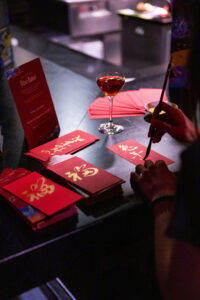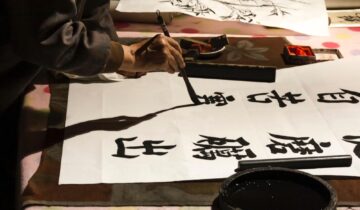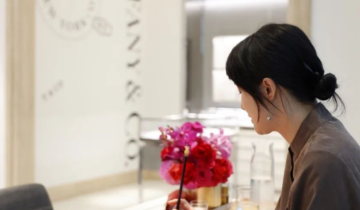What is Chinese Writing?
Chinese calligraphy is the writing of Chinese characters as an art form, uniting visual art and interpretation from its meaning. It is one of the most practiced ancient arts in China. Poets and painters were commonly great calligraphers. Chinese writing is not only perceived as an aesthetic form of writing, but also as a way to elevate an individual’s personal character.
Chinese writing can be used to write traditional greetings on a variety of traditional stationery and products including lai see envelopes, scrolls, fans and lanterns. Our artists at The Calligraphy Co. specialise in traditional and simplified Chinese calligraphy and painting traditions, which can be applied to traditional stationery and products, as well as modern luxury brand stationery, products and product packaging.
What Are The 6 Types of Chinese Writing?
Six major styles of Chinese writing have developed over the course of more than three thousand years.
1. Oracle Bone Script
The Oracle bone script is the earliest known form of Chinese writing, dates from the 14th to 11th century BCE. However, it was discovered and deciphered in the early 20th century. Archaeologists in the early 20th century discovered this type of Chinese writing and modern scholars have recently added it to China’s tradition of calligraphy writing types. It was practiced in the form of pictographic inscriptions on the flat bones of specific animal turtle shells. The texts served a divinatory purpose, and was used in predicting future events on behalf of the leader.
2. Seal Script
Seal script, otherwise known as Seal or Zuan Style, exists in two different forms. The earlier form was called large or great seal script. They were predominantly used mostly for celebratory purposes. The other form is known as small-seal script which came later and was considered a standardised system of writing under Qin dynasty’s first emperor. This form of Chinese writing was frequently used for solumn writing on stone monuments.
3. Clerical Script
Clerical style, also known as Li stylem was commonly used in preparing official records and documents, as well as for public monuments. This form of Chinese writing is considered the simplified variation of seal script and was practiced with a brush on bamboo or wooden material.
4. Running Script
Running style was also known as semi cursive script or Tsao style. Due to its ease, convenience, and legibility, running script quickly became the most popular form of Chinese writing in daily use, even in today’s day and age.
5. Cursive Script
The characters inherit a rounded, edgeless appearance, and resemble the grass shaked by the wind. Therefore it is commonly referred to as Grass script in China. The merging of the strokes allows writers to often write without lifting the brush from the surface. Hence, this type of Chinese writing allows for more freedom and in the expression of emotions
6. Standard Script
Standard script is considered to contain the highest number of strokes, written separately, slowly and attentively. It also has stricter rules when it comes to their width and sizes. This form of Chinese calligraphy is the first style taught to children, and is the starting point for the majority ofl modern printed materials. This is because it is the clearest and easiest form of Chinese writing to read.
Brand Activation & Calligraphy Services
If you are looking for the finest Chinese calligraphy artisans across Australia and New Zealand to enhance your brand activation or event, visit our website for more information or contact us to discuss how we can tailor a memorable experience for your valued clients and guests.
In addition to Chinese calligraphy, The Calligraphy Co. artisans provide a broad range of bespoke artisanal services, including custom embroidery, western modern and traditional calligraphy, fashion and product illustration, leather and product embossing, hand engraving and more.



